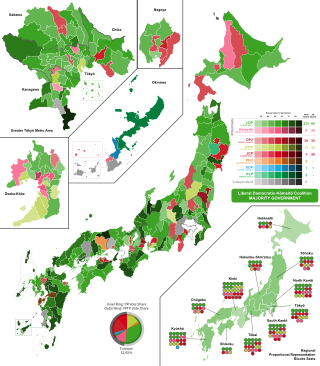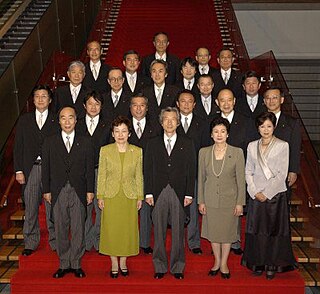
Politics of Japan are conducted in a framework of a dominant-party bicameral parliamentary constitutional monarchy, in which the Emperor is the head of state and the Prime Minister is the head of government and the head of the Cabinet, which directs the executive branch.

Junichiro Koizumi is a Japanese retired politician who was Prime Minister of Japan and President of the Liberal Democratic Party (LDP) from 2001 to 2006. He retired from politics in 2009. He is the sixth-longest serving Prime Minister in Japanese history.

The Liberal Democratic Party, frequently abbreviated to LDP or Jimintō (自民党), is a major conservative and Japanese nationalist political party in Japan.

The Democratic Party of Japan was a centrist to centre-left liberal or social-liberal political party in Japan from 1998 to 2016.

The New Frontier Party (NFP) was a big tent political party in Japan founded in December 1994. As a merger of several small parties, the party was ideologically diverse, with its membership ranging from moderate social democrats to liberals and conservatives. The party dissolved in December 1997, with Ichirō Ozawa's faction forming the Liberal Party and other splinters later joining the Democratic Party of Japan in April 1998.

General elections were held in Japan on 11 September 2005 for all 480 seats of the House of Representatives, the lower house of the Diet. Prime Minister Junichiro Koizumi called the election almost two years before the end of the term taken from the previous elections in 2003, after bills to privatize Japan Post were voted down in the upper house, despite strong opposition from within his own Liberal Democratic Party (LDP).

The People's New Party was a Japanese political party formed on August 17, 2005, in the aftermath of the defeat of Prime Minister Junichiro Koizumi's Japan Post privatisation bills which led to a snap election. On March 21, 2013, party leader Shozaburo Jimi announced that he was disbanding the party.

The New Party Nippon was a Japanese political party formed on August 21, 2005. The party was headed by the former Nagano governor Yasuo Tanaka, and includes Diet members Kōki Kobayashi, Takashi Aoyama, Makoto Taki, and Hiroyuki Arai, who left the Liberal Democratic Party in opposition to Prime Minister Junichiro Koizumi’s postal privatization drive.

General elections were held in Japan on 20 October 1996. A coalition of the Liberal Democratic Party, New Party Sakigake and the Social Democratic Party, led by incumbent Prime Minister Ryutaro Hashimoto of the LDP won the most seats.

House of Councillors elections were held in Japan on July 29, 2007. The date was originally to be July 22, but the ruling Liberal Democratic Party (LDP) decided in mid-June to extend the session of the House for a week to finish up legislative business; this step was criticised due to the short-term delay.

House of Councillors elections were held in Japan on 29 July 2001. They were the first national elections since Junichiro Koizumi became Prime Minister after Yoshiro Mori resigned in April 2001. The Liberal Democratic Party (LDP) and its election allies, were the major winner, provided Koizumi a strong mandates to move forward with his reform policies. The ruling coalition performed well, and regain their majority in the House of Councillors.

House of Councillors elections were held in Japan on 12 July 1998.

General elections were held in Japan on August 30, 2009 to elect the 480 members of the House of Representatives. The opposition Democratic Party of Japan (DPJ) defeated the ruling coalition in a landslide, winning 221 of the 300 constituency seats and receiving 42.4% of the proportional block votes for another 87 seats, a total of 308 seats to only 119 for the LDP.

Prefectural elections for the Tokyo Metropolitan Assembly were held on 12 July 2009. In the runup to the Japanese general election due by October they were seen as an important test for Taro Aso's ruling coalition of the Liberal Democratic Party (LDP) and the New Komeito. New Komeito considers Tokyo as an important stronghold and had repeatedly asked Prime Minister Aso to avoid holding the two elections within a month of each other.

The Shikoku proportional representation block is one of eleven proportional representation (PR) "blocks", multi-member constituencies for the House of Representatives in the Diet of Japan. It consists of Shikoku region covering Tokushima, Kagawa, Ehime and Kōchi Prefectures. Following the introduction of proportional voting it elected seven representatives in the 1996 general election. When the total number of PR seats was reduced from 200 to 180, the Shikoku PR block shrank to six seats.

Yamaguchi 4th district is a single-member electoral district for the House of Representatives, the lower house of the National Diet of Japan. It is located in Western Yamaguchi and consists of the cities of Shimonoseki and Nagato. The seat was held by former Prime Minister of Japan Shinzo Abe until his assassination in July 2022. As of September 2011, 266,456 voters were registered in the district, giving its voters well above average vote weight. Unlike many prefectures where the capital is also the most populous city, Yamaguchi's major city is Shimonoseki, located at the western tip of Honshū and adjacent to Kyushu island's Fukuoka-Kitakyūshū metropolitan area which lies just south across the Kanmon Straits.

General elections were held in Japan on 14 December 2014. Voting took place in all Representatives constituencies of Japan including proportional blocks to elect the members of the House of Representatives, the lower house of the National Diet of Japan. As the cabinet resigns in the first post-election Diet session after a general House of Representatives election, the lower house election also led to a new election of the prime minister in the Diet, won by incumbent Shinzō Abe, and the appointment of a new cabinet. The voter turnout in this election remains the lowest in Japanese history.

General elections were held in Japan on 22 October 2017. Voting took place in all Representatives constituencies of Japan – 289 single-member districts and eleven proportional blocks – in order to appoint all 465 members of the House of Representatives, the lower house of the then 707-member bicameral National Diet of Japan. Incumbent Prime Minister Shinzō Abe's governing coalition of the Liberal Democratic Party (LDP) and the Komeito party retained their seats in signs of what was perceived as weak opposition. The PM won his fourth term in office and held on to the two-thirds supermajority in order to implement policies on revising the war-renouncing Article 9 of the Japanese Constitution.

The Second Koizumi Cabinet was the cabinet of Japanese Prime Minister Junichiro Koizumi during his second term from November 2003 to September 2005. The cabinet was formed after the coalition of the Liberal Democratic Party and the Komeito was re-elected with a slightly reduced majority at the November 2003 general elections. The LDP lost 10 of its pre-election seats to become a minority in the National Diet, but immediately regained a majority by absorbing its coalition partner, the New Conservative Party. Koizumi had reshuffled the cabinet less than two months before the election, and so made no changes when he was re-elected by the Diet on November 19.
The 1994 electoral reform in Japan was a change from the previous single non-transferable vote (SNTV) system of multi-member districts (MMD) to a mixed electoral system of single-member districts (SMD) with plurality voting and a party list system with proportional representation. The reform had three main objectives: change the one-party dominance of the Liberal Democratic Party (LDP) from the previous 1955 system to a two-party system with alternation in power, reduce the cost of elections and campaigns, and change campaign focus from individual-centered to party-centered.





















